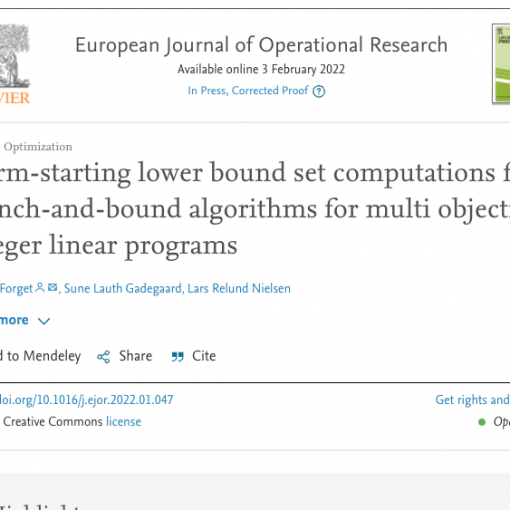The research paper “Biobjective Branch-and-Cut Algorithms Based on LP Relaxation and Bound Sets” have been published in Informs Journal on Computing
Abstract: Most real-world optimization problems are of a multi-objective nature, involving objectives which are conflicting and incomparable. Solving a multi-objective optimization problem requires a method which can generate the set of rational compromises between the objectives. In this paper, we propose two distinct bound set based branch-and-cut algorithms for bi-objective combinatorial optimization problems, based on implicitly and explicitly stated lower bound sets, respectively. The algorithm based on explicitly given lower bound sets computes for each branching node a lower bound set and compares it to an upper bound set. The implicit bound set based algorithm, on the other hand, fathoms branching nodes by generating a single point on the lower bound set for each local nadir point. We outline several approaches for fathoming branching nodes and we propose an updating scheme for the lower bound sets that prevents us from solving the bi-objective LP-relaxation of each branching node. To strengthen the lower bound sets, we propose a bi-objective cutting plane algorithm that dynamically adjusts the weights of the objective functions such that different parts of the feasible set are strengthened by cutting planes. In addition, we suggest an extension of the branching strategy “Pareto branching”. Extensive computational results obtained for the bi-objective single source capacitated facility location problem prove the effectiveness of the algorithms.
More over the research paper “An approximate dynamic programming approach for sequential pig marketing decisions at herd level” have been published in European Journal of Operational Research
Abstract: One of the most important operations in the production of growing/finishing pigs is the marketing of pigs for slaughter. While pork production can be managed at different levels (animal, pen, section, or herd), it is beneficial to consider the herd level when determining the optimal marketing policy due to inter-dependencies, such as those created by fixed transportation costs and cross-level constraints. In this paper, we consider sequential marketing decisions at herd level. A high-dimensional infinite-horizon Markov decision process (MDP) is formulated which, due to the curse of dimensionality, cannot be solved using standard MDP optimization techniques. Instead, approximate dynamic programming (ADP) is applied to solve the model and find the best marketing policy at herd level. Under the total expected discounted reward criterion, the proposed ADP approach is first compared with a standard solution algorithm for solving an MDP at pen level to show the accuracy of the solution procedure. Next, numerical experiments at herd level are given to confirm how the marketing policy adapts itself to varying costs (e.g., transportation cost) and cross-level constraints. Finally, a sensitivity analysis for some parameters in the model is conducted and the marketing policy found by ADP is compared with other well-known marketing polices, often applied at herd level.


